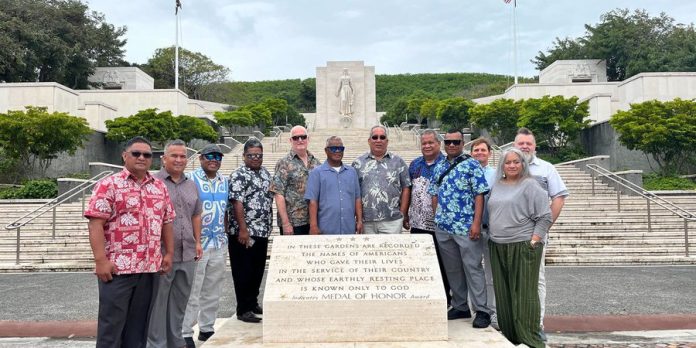Within the next 40 years, the Marshall Islands will cease to exist.
That’s according to the Kwajalein Atoll Sustainability Laboratory (KASL), citing U.S Department of Defence research that projects the chain of volcanic islands and coral atolls will be uninhabitable as early as 2035 and no later than 2065.
Marshallese leaders and members of KASL, a project of the Marshallese government and the U.S Office of Naval Research, were in Honolulu this week to meet with scientists, military leaders, and community members to discuss economic opportunities and cultural preservation.
“We live in a very small island setting, atoll community settings, which is nothing but a very small narrow strip of land,” said David Paul, Senator from the Nitijela Parliament, and Board Chairman of the Kwajalein Atoll Development Authority. “What are the best practices and leveraging existing and emerging technologies and how we can mitigate the impact of climate change?”
“They are looking at an existential threat for a place that they have lived for thousands of documented years,” said Dr Eric Rasmussen, KASL research director.
“We have the opportunity to try something in Kwajalein Atoll that might become either a partial adaptation strategy for the Marshallese, or something that may eventually be more general, something that recognising that climate change is going to happen to everybody. The Marshallese might be early in having the opportunity to test and by the time other people need that thing, that thing will be mature, will be at scale, and will be something available for a much wider range of people.”
The KASL group met with leaders from Pacific RISA, Manoa Heritage Centre and the Pacific Gateway Centre, Lt. Commander Jake Baldassini was among those who joined discussions, representing the U.S Coast Guard.
“The rising sea levels will affect the ability of the Marshall Islands to sustain the freshwater lens that provides drinking water to the island. The more awareness there is for things like that, the better position that we are going to be to start implementing solutions as they become more clear to us what the best course of action is,” Baldassini said.
The crisis has prompted tens of thousands of Marshallese to leave their home and live outside of their country. U.S treaties known as the Compacts of Free Association (COFA) allow Marshallese to live and work in the United States. About 10,000 live in Hawaii, with more migrants expected as the crisis worsens.
“We’ve been in these islands for over 3,000 years. And I think we deserve our place in our ancestral home. So mass migration is really not an option,” Paul said. “We have to find ways to ensure that we continue to maintain a physical presence in the Marshall Islands, how do we do that? We’re gonna require a lot of financial resources, we need to make sure that we have a robust and comprehensive and practical adaptation plan.”
“It’s not just about the Marshall Islands, this is about our planet,” said kumu hula Kilohana Silve, who performed an oli and hula to welcome the visiting group at the Manoa Heritage Centre.
“People have to understand that. It’s not helping neighbors in distress. Collectively, we’re all in distress. It concerns every single one of us.”
The Marshallese may be climate change refugees, but leaders say they’re taking control of their destiny.
“If we want our culture and our language to continue to survive and thrive in this complex world, of globalisation and integration, we need to make sure that our people are productive, and be able to adapt and be resilient,” Paul said. “We are survivors, we’re fighters, we’re navigators, we’re not victims,” he said.
SOURCE: HAWAII NEWS/PACNEWS














